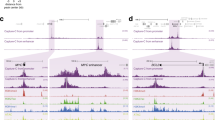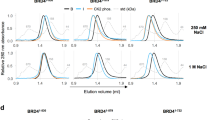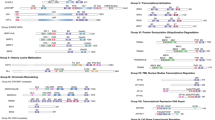Abstract
Proteins of the bromodomain and extraterminal (BET) family, in particular bromodomain-containing protein 4 (BRD4), are of great interest as biological targets. BET proteins contain two separate bromodomains, and existing inhibitors bind to them monovalently. Here we describe the discovery and characterization of probe compound biBET, capable of engaging both bromodomains simultaneously in a bivalent, in cis binding mode. The evidence provided here was obtained in a variety of biophysical and cellular experiments. The bivalent binding results in very high cellular potency for BRD4 binding and pharmacological responses such as disruption of BRD4–mediator complex subunit 1 foci with an EC50 of 100 pM. These compounds will be of considerable utility as BET/BRD4 chemical probes. This work illustrates a novel concept in ligand design—simultaneous targeting of two separate domains with a drug-like small molecule—providing precedent for a potentially more effective paradigm for developing ligands for other multi-domain proteins.
This is a preview of subscription content, access via your institution
Access options
Subscribe to this journal
Receive 12 print issues and online access
$259.00 per year
only $21.58 per issue
Buy this article
- Purchase on SpringerLink
- Instant access to full article PDF
Prices may be subject to local taxes which are calculated during checkout





Similar content being viewed by others
References
Vidler, L.R., Brown, N., Knapp, S. & Hoelder, S. Druggability analysis and structural classification of bromodomain acetyl-lysine binding sites. J. Med. Chem. 55, 7346–7359 (2012).
Prinjha, R.K., Witherington, J. & Lee, K. Place your BETs: the therapeutic potential of bromodomains. Trends Pharmacol. Sci. 33, 146–153 (2012).
Nicodeme, E. et al. Suppression of inflammation by a synthetic histone mimic. Nature 468, 1119–1123 (2010).
Mirguet, O. et al. Discovery of epigenetic regulator I-BET762: lead optimization to afford a clinical candidate inhibitor of the BET bromodomains. J. Med. Chem. 56, 7501–7515 (2013).
Filippakopoulos, P. et al. Selective inhibition of BET bromodomains. Nature 468, 1067–1073 (2010).
Wu, S.-Y. & Chiang, C.-M. The double bromodomain-containing chromatin adaptor Brd4 and transcriptional regulation. J. Biol. Chem. 282, 13141–13145 (2007).
Vollmuth, F., Blankenfeldt, W. & Geyer, M. Structures of the dual bromodomains of the P-TEFb-activating protein Brd4 at atomic resolution. J. Biol. Chem. 284, 36547–36556 (2009).
Delmore, J.E. et al. BET bromodomain inhibition as a therapeutic strategy to target c-Myc. Cell 146, 904–917 (2011).
Dawson, M.A. et al. Inhibition of BET recruitment to chromatin as an effective treatment for MLL-fusion leukaemia. Nature 478, 529–533 (2011).
Stathis, A. et al. Results of a first-in-man phase I trial assessing OTX015, an orally available BET-bromodomain (BRD) inhibitor, in advanced hematologic malignancies. Eur. J. Cancer 50, 196 (2014).
Bradbury, R.H. et al. Discovery of AZD3514, a small-molecule androgen receptor downregulator for treatment of advanced prostate cancer. Bioorg. Med. Chem. Lett. 23, 1945–1948 (2013).
Loddick, S.A. et al. AZD3514: a small molecule that modulates androgen receptor signaling and function in vitro and in vivo. Mol. Cancer Ther. 12, 1715–1727 (2013).
Quinn, E. et al. BROMOscan—a high throughput, quantitative ligand binding platform identifies best-in-class bromodomain inhibitors from a screen of mature compounds targeting other protein classes. Cancer Res. 73, 4238 (2013).
Morris, J. et al. NCI-60 response profiles of >400 investigational oncology agents: a resource enabling drug and biomarker discovery. Mol. Cancer Ther. 12, A102 (2013).
Morris, J. et al. Interrogation of NCI-60 patterns of growth inhibition in conjunction with investigational oncology agents kinase profiling for the elucidation of mechanistic targets. Cancer Res. 74, 5475 (2014).
Asangani, I.A. et al. Therapeutic targeting of BET bromodomain proteins in castration-resistant prostate cancer. Nature 510, 278–282 (2014).
Feng, Q. et al. An epigenomic approach to therapy for tamoxifen-resistant breast cancer. Cell Res. 24, 809–819 (2014).
Williams, F.P., Milbradt, A.G., Embrey, K.J. & Bobby, R. Segmental isotope labelling of an individual bromodomain of a tandem domain BRD4 using sortase A. PLoS One 11, e0154607 (2016).
Lebowitz, J., Lewis, M.S. & Schuck, P. Modern analytical ultracentrifugation in protein science: a tutorial review. Protein Sci. 11, 2067–2079 (2002).
Brown, P.H. & Schuck, P. Macromolecular size-and-shape distributions by sedimentation velocity analytical ultracentrifugation. Biophys. J. 90, 4651–4661 (2006).
Mertens, H.D. & Svergun, D.I. Structural characterization of proteins and complexes using small-angle X-ray solution scattering. J. Struct. Biol. 172, 128–141 (2010).
Tria, G., Mertens, H.D., Kachala, M. & Svergun, D.I. Advanced ensemble modelling of flexible macromolecules using X-ray solution scattering. IUCrJ 2, 207–217 (2015).
Machleidt, T. et al. NanoBRET—a novel BRET platform for the analysis of protein–protein interactions. ACS Chem. Biol. 10, 1797–1804 (2015).
Baud, M.G.J. et al. A bump-and-hole approach to engineer controlled selectivity of BET bromodomain chemical probes. Science 346, 638–641 (2014).
Philpott, M. et al. Assessing cellular efficacy of bromodomain inhibitors using fluorescence recovery after photobleaching. Epigenetics Chromatin 7, 14–25 (2014).
Robers, M.B. et al. Target engagement and drug residence time can be observed in living cells with BRET. Nat. Commun. 6, 10091 (2015).
Whyte, W.A. et al. Master transcription factors and mediator establish super-enhancers at key cell identity genes. Cell 153, 307–319 (2013).
Hnisz, D. et al. Super-enhancers in the control of cell identity and disease. Cell 155, 934–947 (2013).
Creyghton, M.P. et al. Histone H3K27ac separates active from poised enhancers and predicts developmental state. Proc. Natl. Acad. Sci. USA 107, 21931–21936 (2010).
Lovén, J. et al. Selective inhibition of tumor oncogenes by disruption of super-enhancers. Cell 153, 320–334 (2013).
Arrowsmith, C.H. et al. The promise and peril of chemical probes. Nat. Chem. Biol. 11, 536–541 (2015).
Bradbury, R.H. et al. Optimization of a series of bivalent triazolopyridazine based bromodomain and extraterminal inhibitors: the discovery of (3R)-4-[2-[4-[1-(3-methoxy-[1,2,4]triazolo[4,3-b]pyridazin-6-yl)-4-piperidyl]phenoxy]ethyl]-1,3-dimethyl-piperazin-2-one (AZD5153). J. Med. Chem. 59, 7801–7817 (2016).
Chen, H. et al. AZD5153: a novel bivalent BET bromodomain inhibitor highly active against hematologic malignancies. Mol. Cancer Ther. http://dx.doi.org/10.1158/1535-7163.MCT-16-0141 (2016).
Krishnamurthy, V.M., Estroff, L.A. & Whitesides, G.M. Multivalency in ligand design. in Fragment-based Approaches in Drug Discovery (eds. Jahnke, W. & Erlanson, D.A.) Ch. 2 (Wiley, Weinheim, Germany, 2006).
Arnold, D.L., Foreman, K.W., Jin, M., Wanner, J. & Werner, D.S. Preparation of bivalent bromodomain ligands for treating a disease associated with a protein having tandem bromodomains. International patent application WO2013033268 A2 (2013).
Arnold, D.L., Foreman, K.W. & Werner, D.S. Preparation of bivalent bromodomain ligands, and methods of using the same. International patent application WO2015081284 (2015).
Sun, H. et al. Design, synthesis, and characterization of a potent, nonpeptide, cell-permeable, bivalent Smac mimetic that concurrently targets both the BIR2 and BIR3 domains in XIAP. J. Am. Chem. Soc. 129, 15279–15294 (2007).
Jacobson, R.H., Ladurner, A.G., King, D.S. & Tjian, R. Structure and function of a human TAFII250 double bromodomain module. Science 288, 1422–1425 (2000).
Ruthenburg, A.J., Li, H., Patel, D.J. & Allis, C.D. Multivalent engagement of chromatin modifications by linked binding modules. Nat. Rev. Mol. Cell Biol. 8, 983–994 (2007).
Morinière, J. et al. Cooperative binding of two acetylation marks on a histone tail by a single bromodomain. Nature 461, 664–668 (2009).
Ruthenburg, A.J. et al. Recognition of a mononucleosomal histone modification pattern by BPTF via multivalent interactions. Cell 145, 692–706 (2011).
Buttar, D. et al. A combined spectroscopic and crystallographic approach to probing drug-human serum albumin interactions. Bioorg. Med. Chem. 18, 7486–7496 (2010).
Camenisch, G. et al. Estimation of permeability by passive diffusion through Caco-2 cell monolayers using the drugs' lipophilicity and molecular weight. Eur. J. Pharm. Sci. 6, 313–319 (1998).
Kabsch, W. XDS. Acta Crystallogr. D Biol. Crystallogr. 66, 125–132 (2010).
McCoy, A.J. et al. Phaser crystallographic software. J. Appl. Crystallogr. 40, 658–674 (2007).
Emsley, P., Lohkamp, B., Scott, W.G. & Cowtan, K. Features and development of Coot. Acta Crystallogr. D Biol. Crystallogr. 66, 486–501 (2010).
Bricogne, G. et al. Buster Version 2.11.6. (Global Phasing Ltd., 2011).
Smart, O.S. et al. Grade Version 1.2.9. (Global Phasing Ltd., 2011).
Callis, R. et al. A screening assay cascade to identify and characterize novel selective estrogen receptor downregulators (SERDs). J. Biomol. Screen. 20, 748–759 (2015).
Zhang, J.H., Chung, T.D. & Oldenburg, K.R. A simple statistical parameter for use in evaluation and validation of high throughput screening assays. J. Biomol. Screen. 4, 67–73 (1999).
Zava, D.T., Landrum, B., Horwitz, K.B. & McGuire, W.L. Androgen receptor assay with [3H]methyltrienolone (R1881) in the presence of progesterone receptors. Endocrinology 104, 1007–1012 (1979).
Delaglio, F. et al. NMRPipe: a multidimensional spectral processing system based on UNIX pipes. J. Biomol. NMR 6, 277–293 (1995).
Helmus, J.J. & Jaroniec, C.P. Nmrglue: an open source Python package for the analysis of multidimensional NMR data. J. Biomol. NMR 55, 355–367 (2013).
Pernot, P. et al. Upgraded ESRF BM29 beamline for SAXS on macromolecules in solution. J. Synchrotron Radiat. 20, 660–664 (2013).
Franke, D., Kikhney, A.G. & Svergun, D.I. Automated acquisition and analysis of small angle X-ray scattering data. Nuc. Inst. Meth. A. 689, 52–59 (2012).
Svergun, D.I. Determination of the regularization parameter in indirect-transform methods using perceptual criteria. J. Appl. Crystallogr. 25, 495–503 (1992).
Svergun, D.I. Restoring low resolution structure of biological macromolecules from solution scattering using simulated annealing. Biophys. J. 76, 2879–2886 (1999).
Svergun, D.I., Barberato, C. & Koch, M.H.J. CRYSOL–a program to evaluate X-ray solution scattering of biological macromolecules from atomic coordinates. J. Appl. Crystallogr. 28, 768–773 (1995).
Ortega, A., Amorós, D. & García de la Torre, J. Prediction of hydrodynamic and other solution properties of rigid proteins from atomic- and residue-level models. Biophys. J. 101, 892–898 (2011).
Schlessinger, A., Liu, J. & Rost, B. Natively unstructured loops differ from other loops. PLoS Comput. Biol. 3, e140 (2007).
Kim, D., Langmead, B. & Salzberg, S.L. HISAT: a fast spliced aligner with low memory requirements. Nat. Methods 12, 357–360 (2015).
Love, M.I., Huber, W. & Anders, S. Moderated estimation of fold change and dispersion for RNA-seq data with DESeq2. Genome Biol. 15, 550 (2014).
Acknowledgements
The authors thank G. Carr, S. Lamont, T. Moss, A. Patel and G. Wrigley for the synthesis of test compounds; H. Ashton for coordinating biological testing at DiscoverX; K. Eckersley and P. McArdle for supporting cellular imaging studies; and P. Filippakopoulos for BRD4 mutant vector constructs. We thank K. Embrey for helpful comments on the compilation of the manuscript.
Author information
Authors and Affiliations
Contributions
M.J.W. designed compounds, coordinated chemistry, analyzed and interpreted data and coordinated manuscript preparation. H.C. coordinated cell biology work and analyzed and interpreted biological and biophysical data. A.A.R. designed compounds, carried out computational modeling and structural analysis and interpreted data. G.W. coordinated biophysical testing and AR/ER-based cell experiments and conceived of and coordinated NanoBRET experiments. R.B. designed and carried out NMR studies. S.B. carried out cell biology experiments. R.H.B. designed compounds, coordinated chemistry and analyzed and interpreted data. R.C. carried out ER cell biology experiments. E.C. was the project leader. I.D. carried out NanoBRET experiments. D.L.D. coordinated NanoBRET target engagement experiments and construct production. A.D. coordinated transciptomic profiling and interpreted data. L.F. designed, expressed and purified protein constructs. G.H. analyzed and interpreted biophysical data. T.A.J. carried out AUC experiments and ab initio modeling. A.K. carried out SAXS experiments. M.M. coordinated AUC experiments and analyzed and interpreted biophysical data. J.M. conducted NanoBRET target engagement experiments. D.O. coordinated SAXS experiments and analyzed and interpreted biophysical data. J.P. carried out protein X-ray structure determination. P.P. carried out the c-Myc flow cell assay. G.R.R. carried out computational modeling of tandem domain proteins. M.B.R. carried out NanoBRET target engagement experiments. S.S. carried out transcriptomics experments. N.S. carried out AR cell biology experiments. D.I.S. coordinated and carried out SAXS experiments. W.W. carried out cell biology experiments. D.W. synthesized compounds. D.M.W. analyzed and interpreted the data. Y.Y. carried out transcriptomics experiments. All authors discussed results and commented on the manuscript.
Corresponding authors
Ethics declarations
Competing interests
The work described here was initiated as a project within AstraZeneca. M.J.W., A.A.R., G.W., R.H.B., D.O. and J.P. are former employees of AstraZeneca and may hold stock in the company. H.C., R.B., S.B., R.C., E.C., I.D., A.D., L.F., G.H., M.M., P.P., G.R.R., S.S., N.S., W.W., D.W., D.M.W. and Y.Y. are current employees of AstraZeneca and may hold stock in the company. Promega Corp. carried out the NanoBRET experiments as part of a collaboration with AstraZeneca. D.L.D., J.M. and M.B.R. are employees of Promega Corp. and may hold stock in the company. The University of Manchester carried out the AUC studies at the request of AstraZeneca. T.A.J. is an employee of the University of Manchester. The European Molecular Biology Laboratory carried out the SAXS studies at the request of AstraZeneca. A.K. and D.I.S. are employees of the European Molecular Biology Laboratory.
Supplementary information
Supplementary Text and Figures
Supplementary Results, Supplementary Tables 1–10, Supplementary Figures 1–19 and Supplementary Note 2. (PDF 3096 kb)
Supplementary Note 1
Synthetic Procedures. (PDF 364 kb)
Rights and permissions
About this article
Cite this article
Waring, M., Chen, H., Rabow, A. et al. Potent and selective bivalent inhibitors of BET bromodomains. Nat Chem Biol 12, 1097–1104 (2016). https://doi.org/10.1038/nchembio.2210
Received:
Accepted:
Published:
Issue date:
DOI: https://doi.org/10.1038/nchembio.2210
This article is cited by
-
Effects of bromodomain and extra-terminal inhibitor JQ1 and interleukin-6 on breast cancer cells
Molecular Biology Reports (2023)
-
Phosphorylation-dependent BRD4 dimerization and implications for therapeutic inhibition of BET family proteins
Communications Biology (2021)
-
Trivalent PROTACs enhance protein degradation via combined avidity and cooperativity
Nature Chemical Biology (2021)
-
Enhancer rewiring in tumors: an opportunity for therapeutic intervention
Oncogene (2021)
-
Structural modification of 4, 5-dihydro-[1, 2, 4] triazolo [4, 3-f] pteridine derivatives as BRD4 inhibitors using 2D/3D-QSAR and molecular docking analysis
Molecular Diversity (2021)




